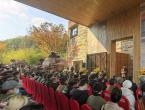Common roots and differences
Common roots and differences
-- Commonalities and differences in the development of Chinese and Russian art
■ Wang Tianhe (Gorita Studio, Repin Institute of St. Petersburg, Russia)
China and Russia share geographical proximity and frequent cultural exchanges, with both countries' arts evolving through the interaction between national traditions and external influences. From the late 19th century to the early 20th century, Chinese society underwent tremendous changes, and Western art gradually made its way in; whereas Russia, influenced by Europe earlier, saw realism and romanticism become the core of its art. Both countries' arts, rooted in their national spirits, have developed unique characteristics through absorption and integration.
Exploring the Commonalities between Chinese and Russian Fine Arts
Realism is the most notable common ground between Chinese and Russian art. Since the establishment of the Peredvizhniki, artists have made it their mission to authentically depict social life. For instance, Repin's "The Volga River's Towers" faithfully portrays the hardships of the lower classes and exposes the contradictions and injustices in society. This dedication to authentically portraying people's lives has influenced numerous Chinese artists. In the early days of the founding of New China, China fully embraced this concept, forming a creative system centered around realism. Works such as Dong Xiwen's "The Founding of the People's Republic of China," "Kazakh Shepherdess," Luo Gongliu's "Chairman Mao on Mount Jinggang," and Liu Yuyi's "Cultivating the Sky" have become typical representatives, sparking much discussion.
Realism is not just a technique, but also a philosophical stance. It emphasizes reflecting the essence of society through authentic images and expressing the emotions of the people. Both Chinese and Soviet artists regard realism as an important means of expressing the spirit of the times, endowing art with a strong social function and historical record significance.
Chinese and Russian artists generally attach great importance to thematic creation and emphasize the political function of art. Soviet paintings often depict themes such as working people, revolutionary struggles, and construction achievements, shaping heroic images, such as Melnikov's "On the Field of Peace" and "The Baltic Navy Pledge". Chinese art also highlights the theme of workers, peasants, and soldiers. For example, Jiang Zhaohe's "The Map of Refugees" not only uses realistic expression to reproduce the characters in Chinese reality, but also expresses criticism of reality through the portrayal of displaced people. Although Xu Beihong's "The Foolish Old Man and the Mountains" and "Nine Squares" do not directly depict characters in reality, they embody the democratic ideology of realistic painting through realistic portrayal and metaphors of reality expressed through historical and mythological stories.
This thematic creation embodies the social mission of art, elevating painting beyond the aesthetic level and transforming it into a tool for education and mobilization.
In terms of art education, both China and Russia take realistic training as the core, emphasizing the fundamentals of sketch, color, and form. Teachers focus on the unity of technical norms and ideological guidance in teaching, cultivating students' sense of social responsibility and artistic mission. In the 1950s, the Maksimov Oil Painting Training Class was successfully established. In response to the current situation of Chinese art education at that time, he placed great emphasis on the concept of "structure" in teaching, which helped people establish a rational sense of order and conventional consciousness. This led to the cultivation of a group of outstanding oil painting talents in China, including Jin Shangyi, Zhan Jianjun, Feng Fasi, and Hou Yimin. Advanced oil painting techniques and teaching concepts were introduced to China with the arrival of Soviet experts, pushing Chinese oil painting teaching towards standardization and scientification.
Analysis of the differences between Chinese and Russian art
Although realism constitutes the commonality of art in both countries, differences in cultural roots lead to distinct artistic temperaments. Russian art is deeply influenced by European classical and religious traditions, emphasizing physical structure and spatial lighting, with a heavy and rational style. Taking Levitan's works as an example, they present the grandeur and tranquility of the Russian land through delicate brushwork and diverse color layers, creating a strong romantic atmosphere. Influenced by early Sagózov and Plév, many works vividly reproduce natural landscapes. In his early creative period, two works, "Dusk" and "The Evening Field," were selected for the Peredvizhniki exhibition.
Chinese art inherits the tradition of ink painting, emphasizing charm, artistic conception, and spiritual expression, with a focus on subjective expression and cultural symbolism. Li Keran, with his outstanding artistic practice and profound theoretical knowledge, became one of the most pioneering representatives, and his landscape paintings are considered typical examples of Chinese ink painting. He not only deeply rooted himself in the tradition of brush and ink that has been passed down since the Song and Yuan dynasties, but also, with a sense of responsibility to write chapters for the mountains and rivers of the motherland, achieved a thorough innovation in artistic language through extensive sketching activities.
Therefore, Chinese realism is not a mere imitation of the West, but a recreation that integrates the spirit of traditional ink and wash. Chinese and Russian art exhibit differences in formal language and aesthetic concepts, ranging from rationality and sensibility to structure and artistic conception.
In terms of aesthetic pursuit and expression techniques, Russian realism emphasizes the shaping of forms and the play of light and shadow, pursuing a sense of weightiness and rational beauty; Chinese realism, on the other hand, places greater emphasis on artistic charm and spiritual imagery, focusing on emotional expression and poetic expression. When artists from the two countries depict similar themes, Russian works tend to be grand and rigorous, while Chinese works are more lyrical and symbolic.
The role and influence of Sino-Russian art exchange
The introduction of the Soviet realism system significantly enhanced the level of art education and creation in China. Scientific sketch training, rigorous modeling methods, and thematic creation concepts facilitated the modernization transformation of Chinese art in the mid-20th century.
Sino-Russian exchanges have not only brought about technological innovations but also prompted Chinese artists to establish the awareness that "art serves society," pushing art from individual expression towards social participation. This philosophy still has an impact today, enabling Chinese art to maintain a sense of practical concern and social responsibility in a diverse context.
After absorbing the experience of the Soviet Union, Chinese artists did not remain at the stage of imitation, but instead combined realism with national traditions. After the reform and opening up, art gradually moved away from a single political theme, exploring personal expression and cultural reflection, and forming a rich and diverse creative pattern. The experience of the Soviet Union provided a methodological foundation for China, while China's innovative practices demonstrated the regenerative ability of foreign models. Sino-Soviet artistic exchanges moved from "transplantation" to "integration", ultimately forming a realistic system with Chinese characteristics. Even in the contemporary pluralistic context, realism remains the core of Chinese art education. It has transformed from a political tool into an artistic foundation, coexisting with various forms such as abstraction, concept, and experimentation.
Although Soviet art declined with the collapse of its system, its realistic tradition and teaching philosophy have been sustained in China, exerting a profound influence on the technical training and creative concepts of contemporary artists. The historical experience of Sino-Russian art exchanges has become an important pillar for Chinese art to maintain its cultural roots in the context of globalization.
In summary, the development of Chinese and Russian fine arts exhibits the characteristics of "sharing a common origin but diverging in multiple directions." This evolution of "common roots and divergences" not only reflects the historical logic of Sino-Soviet artistic relations, but also reveals the universal law of interaction between foreign cultures and national traditions.
Copyright Notice: Original content on this website is welcome to be reposted. Please indicate the source when reposting, Global Art Network www.caanets.com; Some of the content posted on this website comes from the internet. If there is any infringement, please contact this website to delete it.




